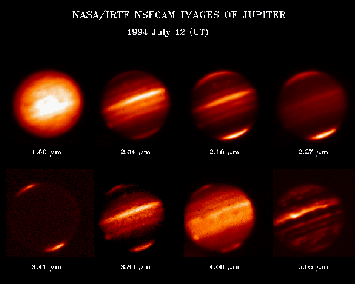

NOTE: Click on the image to view it at its highest resolution.
Image from the NASA/IRTF using the near-infrared 256*256 array camera, NSFCAM.
This July 12 image set shows the typical aspect of Jupiter in 8 different near-infrared "colors". On the top row, images are shown taken in colors that are progressively more affected by gas absorption in the atmosphere (namely, hydrogen and methane, the main absorbers of light in the Jovian atmosphere). The gas absorption prevents light from reaching deep levels in the atmosphere: as that absorption increases (as from left to right in the top row images), only higher and higher levels of the atmosphere can be viewed. At 2.27 um , the very large absorption allows one to see only the stratosphere in any clarity. There, the polar hazes (a thin veil of haze thought to be generated by magnetospheric ions smashing into the hydrogen- and methane-rich atmosphere and therby generating more complex, solid molecules) can be seen. However, much more optically-thick condensate clouds (principally ammonia ice particles) disappear below the gaseous murk, leaving the high-altitude but actually very thin veil of stratospheric polar hazes as the dominant reflector.
The second row shows the polar aurorae in the first three pictures. The leftmost picture is taken in an extremely absorbing wavelength, where methane wipes out virtually every bit of sunlight that strikes the planet. The only light seen from Jupiter is light that Jupiter emits itself from very high altitudes, i.e, auroral emission from the H3+ molecule. The next two images show this aurorae again, but with progressively more contribution from cloud reflections of sunlight as methane absorption becomes progressively less effective, allowing us to see through the "murk" once again to underlying clouds. The last image shows five-micron radiation generated in the relatively-warm deep atmosphere. At this wavelength, the Sun's light is very feeble. The bulk of the radiation that is seen from Jupiter is generated by Jupiter's own heat. However, overlying clouds above the source of heat generation (at about 5 bars pressure) obscures much of this radiation. Light is seen emanating only in relatively cloud-free (or less cloudy) regions of Jupiter...
Submitted by Kevin H. Baines for the NASA IRTF Comet Science Team.